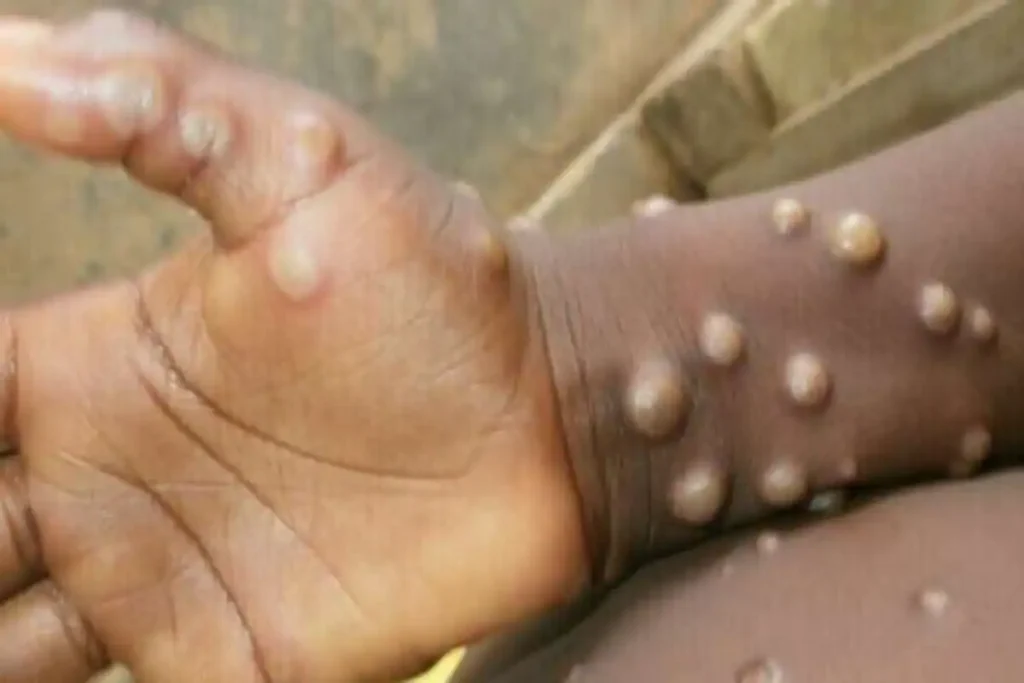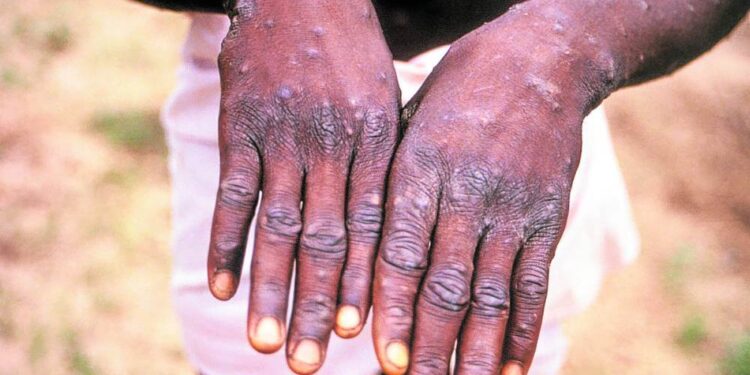Symptoms and treatments of monkeypox are discussed below. The monkeypox rash appears in the genital area of the body, particularly in the early stages of the disease.
KAMPALA | NOW THEN DIGITAL — In the early stages of monkeypox, the rash may not be observable due to the location of the rash in the genital area. In this case, here are some symptoms and treatments of monkeypox.
- Monkeypox usually begins in the genital area and may not be visible in its early stages; read on to learn more about the disease and treatment.
- In the general population, case fatality rates of monkeypox have historically ranged between zero and eleven per cent, with an especially high rate among young children.
- Monkeypox is contagious, and close contact with an infected person can increase the risk of infection.
- Read also: Ashwagandha helps men with careers deal with stress. Here are some of the benefits of Ashwagandha.
Monkeypox rash starts in the genital area and may be less visible in the early stages of the disease.
It is spread from one human to another through close contact, animal bites or scratches, preparing meat from wild game, respiratory droplets, and infested items.
Although it is not always easily spread from one human to another, the infection can be carried by the same animal through close contact.
“We’re seeing more cases where the rash begins in the genital area — which is not new, that has always been there — but it’s more frequent now and sometimes it tends to stay there,” said Dr. Rosamund Lewis, Head of the Smallpox Secretariat at the WHO.
Read on to learn more about the symptoms and treatments of monkeypox.
Case fatality ratio
The case fatality ratio of monkeypox is a relatively low percentage, at around ten to thirty percent. Monkeypox outbreaks in the USA are believed to have occurred because of the importation of infected prairie dogs. These wild animals are the main source of infection.
However, it should be noted that the virus does not transmit well from person to person.
Generally, the disease is spread by eating the infected tissue, but the virus is not easily transmitted.
In recent years, however, the disease has increased in men who have sex with other men. It has also increased among men seeking health care at sexual health clinics and primary care facilities.
However, this disease is not limited to sexually active men. Anyone who has close physical contact with a person infected with monkeypox is at risk.
This increase in incidences may be due to the fact that males are seeking health care more often, rather than being sex-related.
The case fatality ratio of monkeypox has historically ranged between zero and eleven per cent in the general population, with the rate being higher in young children.
However, the recent numbers are at around three to six percent, which takes into account medication-associated allergies and lymphadenopathy. Moreover, it is important to note that this disease is more common than chickenpox.
And, the majority of cases are self-limiting. The symptoms last anywhere from two to four weeks, although they may be severe in rare cases.
There is no specific requirement for reporting cases of monkeypox in other countries. However, it is important to be aware that this disease is still considered an emerging threat in many parts of the world.
In other countries, reporting cases of monkeypox is voluntary, but not in the United States.
In the US, the virus is responsible for approximately one-half of all cases of monkeypox. It is an orthopoxvirus.
Treatment
The rash of monkeypox is a characteristic symptom of the disease. It develops one to three days after the fever begins, typically on the face.
However, it can also occur on other body parts such as the hands, feet, mouth, genitals, and extremities.
The rash typically progresses in a specific pattern, starting as flat, round lesions and progressing to slightly raised, hard bumps filled with clear fluid. The lesions typically scab over after 21 days.
A health care provider can properly diagnose monkeypox. In most cases, the symptoms of monkeypox are similar to those of other infectious diseases.
Treatment for monkeypox is supportive in nature and is not curative. There are currently no proven treatments for monkeypox infection.
Although monkeypox is a treatable disease, the clinical efficacy of available medications is limited.
As such, it is important to seek medical advice from a health care provider if you suspect that you may have been exposed to monkeypox.
Monkeypox is a contagious disease, and close contact with an infected person increases the risk of spreading the disease to others. A patient may be asked to isolate themselves from others at home if the symptoms are mild.
If the symptoms are severe, the patient may be hospitalized, but this is not necessary. Vaccination is available to protect against monkeypox.
Although the disease is not widespread, it is important to note that travel to central and west African countries is advisable for protection against the disease.
While the spread of the virus is unlikely to cause an outbreak, the disease can be easily transmitted to others by direct contact with an infected person.
The virus can also be transmitted through broken skin and mucous membranes.
In fact, the disease can be transmitted via contaminated rodent bedding and bush meat preparation.
There are currently no proven cures for monkeypox, but health care professionals may try smallpox vaccines, antivirals, and vaccine immune globulin.

Vaccines
Vaccines for monkeypox can prevent disease in humans, but a single dose of the JYNNEOS vaccine is insufficient. Vaccines for monkeypox are generally administered as a two-dose regimen with at least four days between shots.
However, some studies have shown that a single dose of the vaccine can prevent infection within four days of exposure. Vaccines for monkeypox are safe to give to children and adults.
Although there are no specific treatments for monkeypox, people who have a weak immune system should be vaccinated.
A vaccine for monkeypox is the best way to prevent infection, as it reduces the risk of serious side effects.
The CDC says that monkeypox is the second most commonly contracted disease in the world, and there are several vaccines available. One is approved by the U.S. Food and Drug Administration.
The Biden-Harris administration is taking the outbreak of monkeypox seriously.
It is increasing the stockpile of the two vaccines available: Tecovirimat, a live replicating virus, and JYNNEOS, a two-dose, non-replicating virus administered through an injection.
The vaccine has been shown to be 85% effective in preventing the disease in humans.
WHO released interim guidance for the use of vaccines for monkeypox. The WHO recommends judicious use of monkeypox vaccines in a national context.
Although mass vaccination for monkeypox is not recommended at this time, post-exposure prophylaxis for contacts of people with monkeypox is encouraged.
These vaccines are best given within four days of exposure.
Incubation period
Incubation periods for monkeypox vary depending on the route of transmission. Recent outbreaks in the Netherlands, where the virus is endemic, have been challenging to determine.
Prior outbreaks were characterized by cases who had traveled to endemic countries or been exposed to infected animals.
However, many cases from the current outbreak have no documented travel history and are men who had sex with other men. Thus, close contact during sexual activity may play a significant role in transmission.
The incubation period for monkeypox varies from six to thirteen days. Symptoms of the disease include fever, malaise, lymph node swelling, and fatigue.
Incubation for monkeypox usually starts with fever and then progresses to other parts of the body. The lesions start healing between 14 and 21 days after contact and spread throughout the body.
The symptoms may last for up to one week and may include back pain and muscle aches.
The symptoms of monkeypox are similar to those of smallpox, but they are milder and less severe. Patients may also experience enlarged lymph nodes, a rash, chills, and exhaustion. Swollen lymph nodes may also occur.
The lesions progress through four stages – macular, vesicular, papular, and pustular – before they develop into a rash. A typical case of monkeypox can take up to five days to develop.
After onset of symptoms, the rash can appear one to five days after initial exposure. The rash is typically raised and begins with raised spots.
Eventually, these rash lesions turn into small blisters filled with fluid, and form scabs. The rash will clear up within two to four weeks.
While the incubation period for monkeypox may be longer than that of chickenpox, it usually resolves within two to four weeks.
Transmission routes
The most common monkeypox cases are now being diagnosed in the Democratic Republic of Congo, with more than four thousand suspected cases in the country by 2020.
If the virus becomes more widespread and transmissible, it could pose a global threat. The virus’s mutation could make it more infectious among humans.
As a result, monkeypox could evolve to spread more rapidly. Here are some ways it can be transmitted among humans:
The primary routes of transmission are through intimate contact, such as sex.
The risk of spreading monkeypox is greatest during the first two weeks after the onset of symptoms.
The risk of infection increases further once the wound crust has formed. Although monkeypox is not contagious before the onset of symptoms, it is highly infectious after the first episode.
The virus is spread through skin-to-skin contact, sexual contact, and touching body parts infected with the disease.
In order to track outbreaks, the CDC and World Health Organization monitor the spread of the disease. Cases are reported from 26 health districts with 512 health zones.
In December 2013, the outbreak in Bokungu Health Zone was investigated. It included 104 possible cases, of which 50 (48.1%) were confirmed by laboratory tests.
The remaining cases tested negative for monkeypox.
A higher than normal household attack rate was observed. One transmission event per nine families was identified. The mean incubation period was eight days.
Incubation periods for monkeypox are six to thirteen days, but may range from five to twenty-one days. Most individuals with monkeypox will have a mild or moderate case of the disease.
The rash begins on the hands and face and eventually spreads to other parts of the body. The rash may be crusted or fluid-filled. When it reaches the skin, it can become dry and scabby.
















